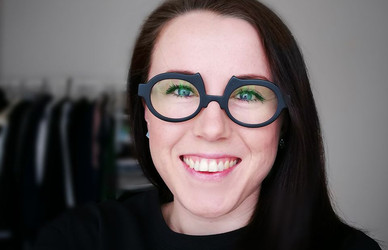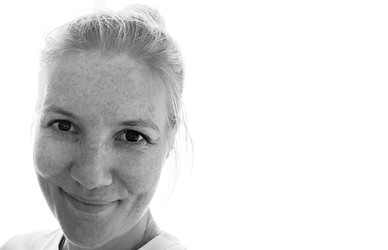Design that loves daily life
21 days to come up with a thought out design. That was the condition that designers Stine Weigelt and Gitte Lægård had to accept when they were both invited to participate in an artistic development collaboration between Design School Kolding, FCB and Coop. A new chair and a new line of textiles for everyday use that had the quality to enter into the long-standing tradition for creating democratic design that FDB and Coop have represented to Danish home owners for decades.
Along with this condition, the two designers were also faced with the expectation that the brief would involve artistic innovation. This meant full speed ahead on the process form day 1.
”One of the briefs said to design a multifunctional chair, a gentleman's hanger in a version with round sticks. Making a piece of furniture not just intended for sitting was an interesting challenge,” says Stine Weigelt:
”At the same time, it had to be an iconic object that marked a transition between the tradition stick chairs and something new. FDB wanted to target a younger segment than usual. And I had three weeks to make it, so it was straight from the shoulder.”
In order to be able to address future users, the designer conducted a survey among people her same her via email and Facebook. Quickly this gave her something to work with: ”The questions were mainly about hallway and bedroom furniture. Things like ‘Where do you put your trousers before going to bed?’ This was to understand the target group. Understand the concept of ’small space living’ where a piece of furniture must have multiple functions.”
A round one, a long one
The basis of the new chair is the pole that characterises FDB’s past chair collection. The designer had to balance between honouring the tradition and challenging it. The experimental exploration is a core element of the type of artistic development project that the chair design was part of, and indeed a series of experiments did help Stine Weigelt attain a number of quick realisations:
”When they saw my portfolio, FDB called me a ’square designer’. This provoked me quite a bit, and made me want to show them. So I have really tried to get to know the chair. Quite quickly I started making small-scale models to test my ideas. I also talked a great deal with the workshop manager at Design School Kolding to make sure I got the technical aspects right. What is the correct balance between a chair that is sculptural but also functional and stable and production friendly?” says Industrial Designer Stine Weigelt.
This direct hands-on approach is also familiar to Textile Designer Gitte Lægård:
”Within a very short deadline we had to produce some suggestions that were spot-on in order to convince Coop. You cannot present something that is only half-finished. So there was a lot to do and very little time to do it,” she says.
As opposed to the chair design, Gitte Lægård had more free rein, and that turned out to be a challenge as well:
”They wanted something woven and something with a long life. Yet, they would also like to see some wild ideas. Where Stine had a historic element to relate to, I did not have any type of textile just the other elements in the Enkel line: a set, a cookware line and a cutlery line.”
Chalk, pots and plates
Gitte Lægård brought much knowledge and experience into the project from a former ficticious school project that she did for Georg Jensen Damask. So she knew the ground principles of kitchen textiles and could relatively quickly immerse herself in the maker phase:
”I am very physical when I design. So I asked to get some plates and pots sent over so I could relate to the existing shapes. I was drawn to the old Aage Sikker Hansen posters and the way he used chalk. When I scaled his strokes and style to new dimensions, something interesting happened. I used Design School Kolding’s digital loom to do some tests and ended up with two suggestions. One that was very focused on the pattern itself, and one that focused on the structures in relation to the weaving technique that was used. This resulted in two different patterns with their own unique traits.”
Gitte Lægård has subsequently reflected on the intense process:
”It was tough but there was a lot of learning involved in trusting one’s own process. To run tests and trials, new prototypes over and over, testing things. Usually I am confident in my own way of doing things and know what to do. So I enjoyed being challenged on other parameters.”
Impressively analogue
Both designers agree that the short deadline and the intense design process paid off. When the proposals were presented three weeks later, FDB and Coop gave them a thumbs up:
“They were impressed by how tactile and analogue we were,” Gitte Lægård recalls: ”Stine brought these small, precise pieces of puppet furniture, and I brought my colour and weaving samples and laid them out on the table. Presenting the objects physically documented our process in a different way than if we had used a computer screen.”
The products were put into production and both designers are pleased with their success of creating everyday design that balances between art and culture:
”Great everyday design is something that surprises you on a daily basis,” Stine Weigelt concludes. ”I hope people will accept the chair as a functional item. In the hallway, in the living room and in the bedroom. My children use it every morning when they have their breakfast. It was not intended as a dining room chair but over time, people will find ways to use it that fit their needs.”
About artistic development work
At Design School Kolding, artistic development work constitutes a significant part of the school’s knowledge base. It composes the foundation for developing methods, pedagogy, practice and competences to the benefit of the designer, the institution and the design profession in general. In connection with the Coop & FDB project, particularly the designer’s reflection on her own process in terms of the methodological and artistic choices made under significant time pressure were at the centre. Industrial Designer Stine Weigelt explains:
”I have never been involved in a design process that ran as smoothly as this one. Everything happened so fast and you had to make some quick decisions. I made those decisions based on my training; the tools and design methods that I have been given at Design School Kolding.”
In 2017, Design School Kolding and the international Cumulus Association will be hosting a large, international conference with the title REDO. The purpose of the conference is to zoom in on design’s role in creating a sustainable future and achieve impact on political decision-making processes. As a prelude to the conference, we will be bringing a series of articles to show Design School Kolding’s research and how we work to bridge the gap between design thinking and design practice.




